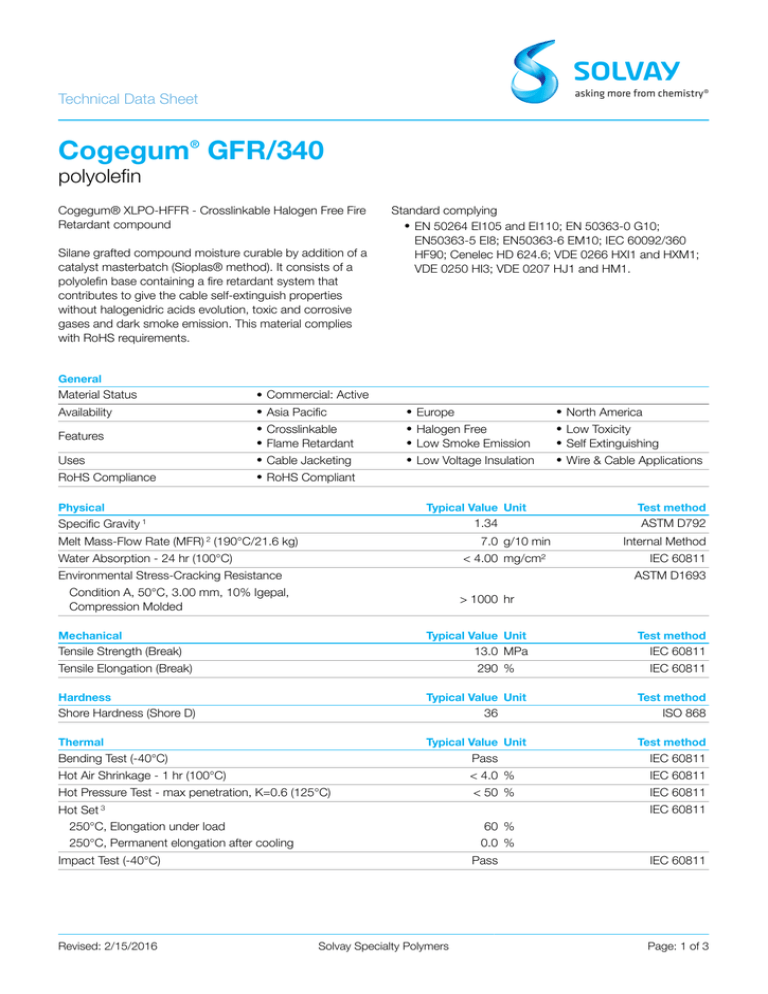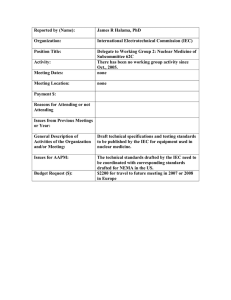
Technical Data Sheet
Cogegum® GFR/340
polyolefin Cogegum® XLPO-HFFR - Crosslinkable Halogen Free Fire
Retardant compound
Silane grafted compound moisture curable by addition of a
catalyst masterbatch (Sioplas® method). It consists of a
polyolefin base containing a fire retardant system that
contributes to give the cable self-extinguish properties
without halogenidric acids evolution, toxic and corrosive
gases and dark smoke emission. This material complies
with RoHS requirements.
Standard complying
• EN 50264 EI105 and EI110; EN 50363-0 G10;
EN50363-5 EI8; EN50363-6 EM10; IEC 60092/360
HF90; Cenelec HD 624.6; VDE 0266 HXI1 and HXM1;
VDE 0250 HI3; VDE 0207 HJ1 and HM1.
General
Material Status
• Commercial: Active
Availability
• Asia Pacific
• Europe
• North America
Features
• Crosslinkable
• Flame Retardant
• Halogen Free
• Low Smoke Emission
• Low Toxicity
• Self Extinguishing
Uses
• Cable Jacketing
• Low Voltage Insulation
• Wire & Cable Applications
RoHS Compliance
• RoHS Compliant
Physical
Typical Value Unit
Specific Gravity 1
1.34 2
7.0 g/10 min
Melt Mass-Flow Rate (MFR) (190°C/21.6 kg)
Water Absorption - 24 hr (100°C)
< 4.00 mg/cm²
Environmental Stress-Cracking Resistance
Condition A, 50°C, 3.00 mm, 10% Igepal,
Compression Molded
Test method
ASTM D792
Internal Method
IEC 60811
ASTM D1693
> 1000 hr
Mechanical
Typical Value Unit
Test method
Tensile Strength (Break)
13.0 MPa
IEC 60811
Tensile Elongation (Break)
290 %
IEC 60811
Hardness
Typical Value Unit
Shore Hardness (Shore D)
36 Thermal
Typical Value Unit
Test method
ISO 868
Test method
Bending Test (-40°C)
Pass IEC 60811
Hot Air Shrinkage - 1 hr (100°C)
< 4.0 %
IEC 60811
Hot Pressure Test - max penetration, K=0.6 (125°C)
< 50 %
IEC 60811
3
IEC 60811
Hot Set
250°C, Elongation under load
250°C, Permanent elongation after cooling
60 %
0.0 %
Impact Test (-40°C)
Revised: 2/15/2016
Pass Solvay Specialty Polymers
IEC 60811
Page: 1 of 3
Cogegum® GFR/340
polyolefin Aging
Typical Value Unit
Mechanical Properties After Aging in Air Bomb, 0.55
MPa, 127°C, 40 hr
Change in Tensile Elongation
Change in Tensile Strength
IEC 60811
-10 %
20 %
Mechanical Properties After Aging in Air Oven, 150°C,
240 hr
Change in Tensile Elongation
Change in Tensile Strength
Electrical
Test method
IEC 60811
-12 %
20 %
Typical Value Unit
Volume Resistivity
20°C
90°C
Test method
IEC 60502
8.2E+14 ohms·cm
5.4E+14 ohms·cm
Insulation Resistance Constant
20°C
90°C
IEC 60502
3000 Mohms·km
2000 Mohms·km
Flammability
Typical Value Unit
Oxygen Index
31 %
Calorific Potential - Upper (gross)
20.3 MJ/kg
Test method
ASTM D2863
ISO 1716
Corrosive Gas in Smoke
Conductivity
pH
IEC 60754-2
< 10.0 µS/mm
> 4.30 Halogenidric Acid Emissions
< 0.10 %
IEC 60754-1
Temperature Index (Burning)
300 °C
NES 715
Additional Information
Tests reported are performed on pressed or extruded specimens, added with 3% of Catalyst CT/2 and crosslinked in hot
water at 95°C for 6 hours
Coloring
• EVA or PE based color masterbatches added at 1.2-1.5% by weight; in order to prevent precrosslinking during
processing, predrying of colour masterbatch is suggested (4-6 hours at 50-60°C)
Storage
• The product must be stored under the following conditions:
• closed and undamaged bags
• ambient temperature not exceeding 30°C
• avoid direct exposure to sunlight and weathering
• Product alterations could occur due to extended period of storage
• Shelf life: 9 months
• Solvay Specialty Polymers accepts no liability of any kind in case the above mentioned conditions are not fulfilled
Packaging
• 25 kg moisture-resistant bags on 1375 kg pallet
• 750 kg carton box
Revised: 2/15/2016
Solvay Specialty Polymers
Page: 2 of 3
Cogegum® GFR/340
polyolefin Extrusion
Typical Value Unit
Cylinder Zone 1 Temp.
130 to 150 °C
Cylinder Zone 2 Temp.
140 to 160 °C
Cylinder Zone 3 Temp.
140 to 160 °C
Cylinder Zone 4 Temp.
150 to 170 °C
Collar Temperature
160 to 180 °C
Head Temperature
160 to 180 °C
Die Temperature
170 to 220 °C
Extrusion Notes
Processing
• Cogegum® GFR/340 pregrafted base must be added with Catalyst CT/2 masterbatch to promote curing. Catalyst
dosage is 3% by weight and blending must be done just before using (2-3 hours max.), preferably in the extruder
hopper. Catalyst doesn't need any predrying if stored in dry conditions in the original closed bags; in case, predrying
can be made at 50-60°C for 4-8 hours
• The pregrafted base compound is sensible to moisture; open bags must be used within 4 hours. Pregrafted base
cannot be predried
Extrusion equipment
• standard extruders for thermoplastics equipped with low compression screw (1:1.2-1.4 compression ratio and 25 L/D
ratio are suggested), and an adequate barrel thermoregulation
• don't use screw thermoregulation
• filter net: none
• compression tools suggested
Curing
• by immersion in hot water at 60-70°C
• by exposure in ambient, crosslinking time depends on ambient temperature and relative humidity
• in all cases curing time depends on insulation thickness; for 0.7-1.2 mm wall thickness 3-6 hours are generally
necessary in case of forced curing in hot water.
Notes
Typical properties: these are not to be construed as specifications.
1
at 23°C
2
test performed without Catalyst MB addition
3
20 N/cm²
SpecialtyPolymers.EMEA@solvay.com
| Europe, Middle East and Africa
| Americas
SpecialtyPolymers.Americas@solvay.com
SpecialtyPolymers.Asia@solvay.com
| Asia and Australia
Safety Data Sheets (SDS) are available by emailing us or contacting your sales representative. Always consult the appropriate SDS before using any of
our products.
Neither Solvay Specialty Polymers nor any of its affiliates makes any warranty, express or implied, including merchantability or fitness for use, or accepts
any liability in connection with this product, related information or its use. Some applications of which Solvay’s products may be proposed to be used
are regulated or restricted by applicable laws and regulations or by national or international standards and in some cases by Solvay’s recommendation,
including applications of food/feed, water treatment, medical, pharmaceuticals, and personal care. Only products designated as part of the Solviva®
family of biomaterials may be considered as candidates for use in implantable medical devices. The user alone must finally determine suitability of any
information or products for any contemplated use in compliance with applicable law, the manner of use and whether any patents are infringed. The
information and the products are for use by technically skilled persons at their own discretion and risk and does not relate to the use of this product in
combination with any other substance or any other process. This is not a license under any patent or other proprietary right.
All trademarks and registered trademarks are property of the companies that comprise the Solvay Group or their respective owners.
© 2016 Solvay Specialty Polymers. All rights reserved.



